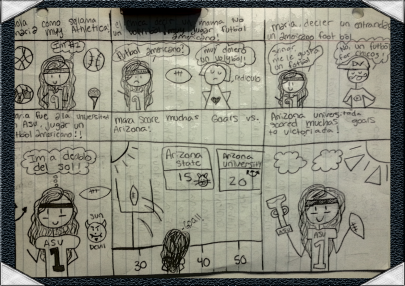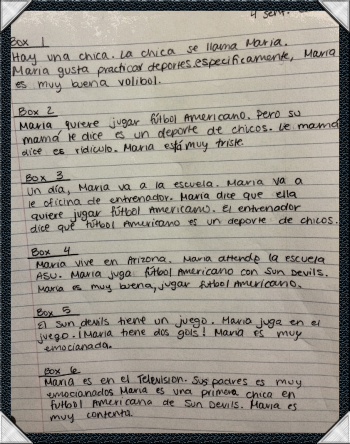Brandon Brown Teaching Script
In workshops the questions often comes up about how to use TPRS using a novel. There are many ways to differentiate instruction while using readers and the teacher resources that are available with the readers are full of rich and well crafted ideas. This past school year I started using Brandon Brown quiere un perro by Carol Gaab (also available in French). Because of the simplicity of this TPRS novel I was able to introduce target language novel reading a bit earlier than usual. The verb querer appears 97 times in the reader and the topic of the book allows for wonderful interaction with beginning students. One of my colleagues, Megan Ramsey, came to observe a few classes and shared her notes with me and I decided to share them here. She was writing a script for herself based on what she saw. Her 2 page document has a lot of language on it and this information was used in a 59 minute course with freshman students in late September/early October.
Teaching with novels can be intimidating if you have never done it before in the context of a language class. If you are new to using the 3 steps of TPRS it can be even more daunting. I was not great at using student actors when I first started using TPRS, nowadays it is a fun way to engage students, create student actor dialogue, and disguise repetition of target grammar and vocabulary.
Here is the word document that you can print or edit.
Here is sample of Megan’s notes.
Student Actors: Brandon, Papá, Mamá, Hermana (Katie), amigo (Jake)
- Pull up a boy “Hay un chico!” El chico se llama Brandon
- Brandon no es adulto, es un niño
- Brandon es un niño y solo tiene ocho años
- Teach “I have eight years”
- ¿Cuántos años tiene Brandon—point to question word
- Brandon tiene 8 años y tiene un papá (bring up another actor)
- El papá se llama Sr. Brown
- ¿Es el padre estricto o flexible?
- Ask student “ Eres tu un padre estricto?
- Tiene una esposa, se llama la Señora Brown (pull up a girl)
- Brandon tiene una papá y una mamá, tiene papas
- ¿Es estricta la madre? Si (get them to say también)
- Pero, la mama de Brandon es muy muy simpática
- ¿Eres tu una mamá? ¿ Eres simpática? Eres tú estricta?
- Tu eres una mama simpática, estricta y generosa
- Hay otra persona en la familia, Si tú piensas es una hermana, levanta la mano
- Es una hermana mayor/ menor?
- ¿Es Brandon un hermano menor o mayor? Ask a student
- Ask ¿Es Kevin correcto?
- Get girls to stand up
- Nosotros buscamos una hermana mayor
TPRS and TCI with advanced students
Thank you Mike Peto for sharing so much with others about using TPRS and Comprehensible Input with advanced students. It is NOT easy following a grammar syllabus with students that already have been exposed to such much grammar, the trick is to get these students processing and using the language faster and more accurately. Check out Mike’s AP syllabus and lessons that he shares.
Enough people come to this blog looking at my AP syllabus that I think it might be valuable to share how I move through that syllabus, maintaining a comprehensible classroom while tackling the content expected by AP. Terry Thatcher Waltz recently pointed out on the moretprs yahoo list that TPRS is best at fostering the acquisition of the basic grammatical structures of a language, while there are other TCI strategies that can develop breadth of vocabulary more efficiently.* That is what I would like to address in this post.
I still use TPRS in AP classes (for example, see by Bryce Hedstrom that helped me understand how TPRS can be used effectively in upper levels). One of my great concerns for the AP class, however, is developing the listening abilities of my non-native students so that they can understand the authentic audio clips on the AP exam. My students need…
View original post 297 more words
ACTFL’s modes of communication in action
ACTFL is helpful for framing lots of ideas for language teachers. However, they never really say how a teacher should conduct class except to suggest that immersion is a key factor for moving students through various stages of proficiency levels. Here are some examples of student work that might help understand some ACTFL’s modes of communication. This activity is a timed listening and drawing class activity that ends by retelling the story in written from.
- Interpersonal (speaking+ listening+reading)
- Interpretive (reading, listening, viewing)
- Presentational (writing, speaking, visually representing)
In this lesson, I used a script that I adapted from MartinaBex.com in order to engage students in the interpersonal mode of communication. Since the textbook theme is sports I use various sport props, gestures for certain actions and point to unknown words on the board (like entrenador). There is a subtle negotiation of meaning because I am almost acting out the story as I tell it. I am tracking comprehension by teaching to the eyes of my students but I am not giving them the opportunity to stop the story. I consider this a mixture of Interpersonal and Interpretive modes of communication as defined by ACTFL.
I add language and details relevant to my audience based on prior knowledge, the level of class, and specific sport teams where we live. Because of the one-way communication, I often hear students say. “Is this a test?” Students are not permitted to stop and ask questions for this one. The one-way communication or dictation lasts 1-3 minutes for each part and then I ring the bell indicating the time to start drawing for each box (dictate, ring, and draw, dictate, ring, and draw…).
Click here to see the script used for creating Interpersonal interaction.

The drawing of what they hear and understand is very much a formative assessment that allows for some student imagination and creativity. In the next part of the lesson I ask students to find a partner and retell the story in written form. I only ask that they write a minimum of 4 sentences. Some do more but the expectation is that they can retell a lot from this story. I am looking for proficiency before accuracy with this activity. Accuracy will occurr slowly overtime and so as long as students are provided large amounts of Comprehensible Input.
We can see that the students derive meaning from this listening comprehension activity. After listening and drawing, I love that they get the chance to work with peers in this part of the lesson. I walk around and often hear students teaching other students grammar pop-up lessons and discussing similar and different details in their story.

This is one way that I incorporate a textbook vocabulary list while maintaining a CI-based curriculum. You can see from the script that I am trying to use words from the “Super Seven.” At the same time, some past grammar and vocabulary themes are used. In the aural teacher presentation of the story new structures like “más que” and “mejor que” were emphasized but have not yet been internalized enough to appear in their output. This output is guiding my instruction. If I want students to write something like “María corre más rápido que todos los chicos,” we have more hours of providing relevant input.
Following further discussions about sports, sporting events, and personalized mini situations, students will have opportunities to read in Spanish about popular sports in the U.S. and Spanish speaking countries.
What should assessment and evaluation look like in the second-language classroom?
Formative assessments aren’t just vocabulary and grammar quizzes before getting to the Unit test anymore. Chris Stolz does a great job discussing assessments in today’s language learning classrooms.
Numberz. Kids, parents, Adminz and teachers all want ’em. “What’s my mark?” asks Baninder. “How can Suzy bring her mark up?” asks Mrs Smith. “How do we get marked?” ask the keeners on Day 1.
Well, here we go, here are some ideas about formative assessment (seeing how people are doing during the learning process), and summative assessment, (a.k.a. evaluation), where we assign a Number to a kid’s performance. Here’s a picture:
There are a few general principles at work which we first need to remember:
A) we should never use norm-referenced (a.k.a. “curved”) grading, for reasons discussed here.
B) We should be doing criterion-referenced grading– i.e. there should be a rubric, or what have you, which clearly defines what needs to be done to get what mark. There are a bazillion rubrics for evaluating second-languages writing, speaking etc out there, from ACTFL guidelines to various State standards…
View original post 1,710 more words
Going Beyond MovieTalks
MovieTalks are now pretty common in a CI -based classroom. Teachers are sharing videos and creating lessons at a rapid pace. One can easily find clips that lend themselves to classroom topics or learning objectives. With the internet, there is no doubt that the quantity of clips are endless but hopefully at the same time, quality control can be maintained by going deep into a story in order to allow students the higher order thinking we so often hear in the teacher world. Blaine and Von Ray presented similar ideas in their advanced workshop in 2014 called “The Power of Going Deep.”
By going deep in MovieTalks, we can allow students to be apart of the story creation process and foster the development of their imaginations, no matter the age group. Once the story is experienced, the purpose of narration and questioning can be understood by our audience. I believe that perhaps a bit of imagination and creativity can be taken away from showing a completed story (instead of creating it with a class through Asking a Story or parallel characters) BUT that is only if we think the story exists on its own and nothing came before or happens afterwards.
https://www.youtube.com/watch?v=JhKQz2TwSAE
Meet Alex, we see him in a short animation trying to exercise and we assume he wants big muscles. In this story he especially wants to impress a girl that is hanging out on the balcony across from his bedroom window. This is the gist of the story but we can discuss so much more than what we see in the clip.
For example, who does Alex live with? Alex can be single and lives in a bachelor pad or perhaps he lives with his parents or as I like to think he is in his late 20’s still living with his mom (this is one back story that my students created this year). To me, that is funny and we might even get to mention something about all the chores his mom makes him do since he doesn’t work. Perhaps he works part time at various jobs. He is kind of thin…what does he eat everyday? Oops, he fell down the stairs…is he coordinated enough to participate in sports?
See what I did there? I incorporated family, chores, professions, food, and sports before even finishing the video. The back story could last for days and students are a part of these conversations every step of the way. The characters help create the Personalized Questions and Answer situations.
Let’s further analyze Alex. Physically he is not very muscular, he seems tall, lazy, serious, and maybe possibly even romantic. Contrasting ser and estar or using n’est pas and est sentences can fit in nicely with this type of story. What is he wearing…is that a “bro tank?” The discussion could also go into elements of teenage life that can be serious. Perhaps Alex grew up being bullied by bigger kids so he is motivated to exercise and defend himself. What about the girl he sees on the balcony? She has a story too. Is this the prettiest girl he has ever seen? Did Alex ever have a girlfriend or does he have lots of girlfriends? We possibly can narrate and interact in the past or using probability with such a story. Continuing the idea of the girl…who is she? Does she live in that house? Is she a visitor or did Alex always hope for this opportunity? We discover that she is blind…what is her life like?
Oh cool…what is like to be in class blindfolded for the day?
These are all ideas that can be discussed in the target language and are matters that call for the use of our imaginations. Using parallel characters, adding locations, surprise details and PQA sessions can take place using MT’s. This is actually no different than what Blaine has ever shared. The main difference that occurs by using a video is that the visual representation is presented very directly. Using MovieTalks has endless possibilities and although students are quickly given a visual representation of the story, we do not have to sacrifice the magic that takes place in story creation. The limitless ideas of “behind the scenes” and back story allows for customization and creativity with our audiences.
There is always more to the the story than just what is on the surface. Happy storytelling!
A MovieTalk lesson
I strategically use MovieTalk lessons throughout the school year. Since I want to maintain a degree of novelty in my classroom I try and wait until the second half of the school year before I start using a variety of MovieTalks. Since I do conduct my classes around a department grammar syllabus, I look for MTs that emphasis recycling the SUPER 7 while introducing what might be grammar found in the syllabus. Our textbook has a unit on sports and exercise and reflexive verbs, so this video allows me to incorporate targeted CI and of course non-targeted CI with a funny story where teenagers get a good laugh.
For this particular lesson (The balcony girl), I have teacher script, embedded readings, an extended reading (in the works), and suggestions for PQA and preteaching vocabulary. I narrate in both present and past tense and also sometimes bring weights to class as a prop or encourage students to have a push-up competition. This lesson can also easily utilize classic TPR and the use of gestures.
YouTube video link. https://www.youtube.com/watch?v=VJJ7eSVjz_Q
Click to view the story script with targeted structures and past tense version. alex quiere hacer ejercicios
Alex quiere hacer ejercicios
Hay un chico que vive en casa con su mamá. Él no es muy atlético pero quiere tener músculos. De hecho este chico no tiene músculos de los brazos ni de las piernas pero los quiere. Vive con su mamá y tiene vientiocho años. El chico no trabaja mucho y es un chico perezoso. El chico va a su dormitorio porque quiere hacer ejercicios. Quiere levantar pesas pero hay un problema, este chico es un poco perezoso.
El chico está en el suelo y quiere hacer flexiones pero finalmente no hace flexiones porque se duerme. El chico se duerme y después se despierta y se levanta. El chico no quiere hacer ejercicios y va a su silla para sentarse. Él se sienta en su la silla y está cansado. De repente algo ocurre. El chico mira por la ventana y ve que hay una chica bonita en el balcón. Él está sorprendido porque quiere hablar con la chica. Este chico tiene una idea. Quiere impresionar la chica del balcón. Va a sus pesas. Este chico tiene muchas pesas. Tiene pesas pequeñas, pesas medianas, y pesas grandes…varias pesas
Él decide usar sus pesas más grandes para impresionarla. Trata de mover sus pesas grandes. Alex pone las pesas enfrente de la ventana y se prepara y se estrecha para levantar las pesas en el aire.
Alex piensa en la chica bonita. Piensa en el amor, el romance, y los besos de la chica y finalmente puede levantar las pesas en el aire. Alex mira por la ventana y ve que la chica bonita no puede ver nada porque es ciega. Alex está sorprendido y las pesas se caen y Alex se lastima. Alex va al hospital y la chica no está impresionada.
For “Freeze Frames” of this story checkout https://www.blendspace.com/lessons/GCJX4hlKraWCqg/la-chica-del-balcon
Looking for this script in French? Here ya go…(disclaimer: I am not a French teacher).
A talk about talking: TeacherTalks
Recently, I had the pleasure of contributing some ideas to the “International Journal of Foreign Language Teaching.” ijlft.org It was an interesting experience because I was challenged with the obstacle of describing something I do “better than anyone else in the classroom.” I wouldn’t want to say I do anything better than anyone else. However, I do attempt to create an immersion-like setting for my students in a sometimes intense way. Since I do this with a grammar and vocabulary based curriculum I must remind myself that…
“Tenses are not acquired as “units” and the brain doesn’t store grammar as a textbook-stated rule (Van Patten).”
The TeacherTalks, as I call them in the article, are an effort to expose students to all the grammar and vocabulary found in their curriculum in a way that is understandable and interesting while allowing the unconscious mind to go to work. I feel there is a great balance in doing these Talks combined with building literacy in the TL. My hope was to help categorize for other teachers ways to create immersion speaking topics.
It is no easy task creating language immersion for 50 minutes day for 180 days per school year in a way that develops fluency. In this area, I believe, teachers can learn from each other sharing best practices in order to build generations of American students that (learn) acquire another language.
Here is the article link.
http://www.ijflt.org/images/ijflt/IJFLT-Dec2014/Coxen-Successful-Reading2.pdf
“Read, Draw, Ask” Sub Plan
I am always wondering what I can leave behind for my students that allows them to develop their fluency, creativity, and doesn’t leave them frustrated. This assignment gives all types of learners an opportunity to shine at any time of the school year.



